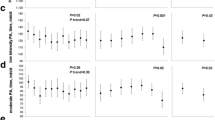Abstract
Compliance with physical activity (PA) recommendations was assessed using objective PA monitoring of ambulatory activity, in two healthy groups of individuals with active and sedentary occupations. The study showed generally low compliance with the guidelines (53% with 10,000 steps a day; 10% with 30 min of moderate activity a day; and 1% with 30 min of moderate activity a day in bouts of at least 10 min (ACSM)). Adherence to guidelines decreased as more rigorous conditions were applied to the PA data. Use of an objective monitor revealed that health enhancing bouts of activity were performed in periods of approximately 1-min duration, which may be due to unavoidable environmental interruptions. These bouts of activity are much shorter than those advocated in the ACSM guidelines, raising questions regarding how actual behaviour, based on objective monitoring, can be reconciled with guidelines based on self-reported PA.

Similar content being viewed by others
References
Ainsworth BE, Levy SS (2004) Assessment of health-enhancing physical activity: methodological issues. In: Oja P, Borms J (eds) Health enhancing physical activity. Meyer & Meyer Sport, Oxford
Blair SN, LaMonte MJ, Nichaman MZ (2004) The evolution of physical activity recommendations: how much is enough? Am J Clin Nutr 79:913S–920S
Godfrey A, Culhane KM, Lyons GM (2007) Comparison of the performance of the activPAL™ professional physical activity logger to a discrete accelerometer-based activity monitor. Med Eng Phys 29:930–934. doi:10.1016/j.medengphy.2006.10.001
Grant PM, Ryan CG, Tigbe WW et al (2006) The validation of a novel activity monitor in the measurement of posture and motion during everyday activities. Br J Sports Med 40:992–997. doi:10.1136/bjsm.2006.030262
Haskell WL, Lee I-M, Pate RR et al (2007) Physical activity and public health: updated recommendation for adults from the American College of Sports Medicine and the American Heart Association. Circulation 116:1081–1093. doi:10.1161/CIRCULATIONAHA.107.185649
Hatano Y (1993) Use of the pedometer for promoting daily walking older adults exercise. ICHPER J 29:4–8
Jakicic JM, Winters C, Lang W et al (1999) Effects of intermittent exercise and use of home exercise equipment on adherence, weight loss, and fitness in overweight women: a randomized trial. JAMA 282:1554–1560. doi:10.1001/jama.282.16.1554
Kesaniemi YK, Danforth E, Jensen MD et al (2001) Dose-response issues concerning physical activity and health: evidence-based symposium. Med Sci Sports Exerc 3:S351–S358
Matthews CE, Ainsworth BE, Thompson RW et al (2002) Sources of variance in daily physical activity levels as measured by an accelerometer. Med Sci Sports Exerc 34:1376–1381. doi:10.1097/00005768-200208000-00021
Miller R, Brown W (2004) Meeting physical activity guidelines and average daily steps in a working population. J Phys Act Health 1:218–226
Moreau KL, Degarmo R, Langley J et al (2001) Increasing daily walking lowers blood pressure in postmenopausal women. Med Sci Sports Exerc 33:1825–1831. doi:10.1097/00005768-200111000-00005
Morris JN, Hardman AG (1997) Walking to health. Sports Med 23:306–332. doi:10.2165/00007256-199723050-00004
Murphy M, Nevill A, Neville C et al (2002) Accumulating brisk walking for fitness, cardiovascular risk, and psychological health. Med Sci Sports Exerc 34:1468–1474. doi:10.1097/00005768-200209000-00011
Pate RR, Pratt M, Blair SN et al (1995) A recommendation from the Centers for Disease Control and Prevention and the American College of Sports Medicine. JAMA 273:402–407. doi:10.1001/jama.273.5.402
Pate RR, Freedson PS, Sallis JF et al (2002) Compliance with physical activity guidelines: prevalence in a population of children and youth. Ann Epidemiol 12:303–308. doi:10.1016/S1047-2797(01)00263-0
Rafferty AP, Reeves MJ, McGee HB, Pivarnik JM (2003) Physical activity patterns among walkers and compliance with public health recommendations. Med Sci Sports Exerc 34:1255–1261. doi:10.1097/00005768-200208000-00005
Ryan CG, Grant PM, Tigbe WW et al (2006) The validity and reliability of a novel activity monitor as a measure of walking. Br J Sports Med 40:779–784. doi:10.1136/bjsm.2006.027276
Schnohr P, Scharling H, Jensen JS (2003) Changes in leisure-time physical activity and risk of death: an observational study of 7,000 men and women. Am J Epidemiol 158:639–644. doi:10.1093/aje/kwg207
Troiano RP, Berrigan D, Dodd KW et al (2008) Physical activity in the United States measured by accelerometer. Med Sci Sports Exerc 40:181–188
Tudor-Locke C, Sisson SB, Collova T et al (2005) Pedometer-determined step count guidelines for classifying waking intensity in young ostensibly healthy population. Can J Appl Physiol 30:666–676
Ward DS, Evenson KE, Vaughn A et al (2005) Accelerometer use in physical activity: best practices and research recommendations. Med Sci Sports Exerc 37:S582–S588. doi:10.1249/01.mss.0000185292.71933.91
Acknowledgments
The data used in this article was collected as part of the PhD studies of Dr William Tigbe, funded by Glasgow Caledonian University. The authors would like to thank Royal Mail Group Ltd for allowing access to their staff for recruitment to this study.
Conflict of interest statement
Professor Malcolm Granat is a named co-inventor of the activity monitor and has a directorship of the company PAL Technologies Ltd., Glasgow, UK. Professor Granat had no involvement in either data collection, or in the statistical analysis of the results. There was no financial contribution to this work from PAL Technologies Ltd.
Author information
Authors and Affiliations
Corresponding author
Rights and permissions
About this article
Cite this article
Chastin, S.F.M., Dall, P.M., Tigbe, W.W. et al. Compliance with physical activity guidelines in a group of UK-based postal workers using an objective monitoring technique. Eur J Appl Physiol 106, 893–899 (2009). https://doi.org/10.1007/s00421-009-1090-x
Accepted:
Published:
Issue Date:
DOI: https://doi.org/10.1007/s00421-009-1090-x




